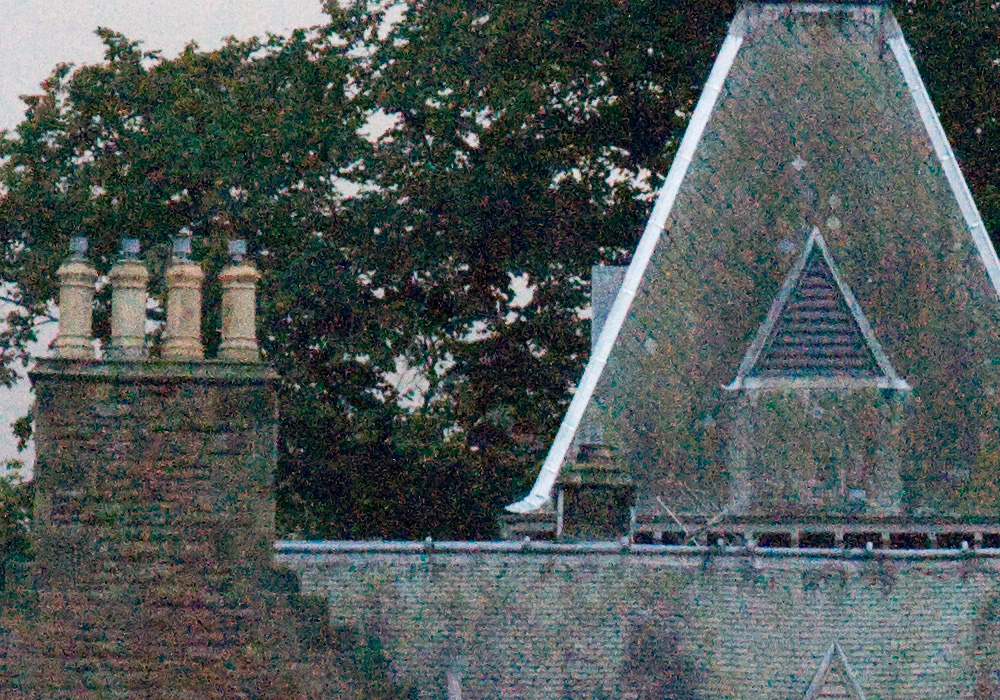Could Sony get 'DxO Inside'?
Here, for easy reference, are two clips from the ACR conversion and the adjusted (darker, less processed) DxO conversion:

ACR is the usual mixture of oatmeal and Christmas tree lights with noise component several pixels in diameter and colour noise clouds far larger.

DxO’s result has just as much fine detail – if not far more, as the tiny twigs in the tree and the faint diagonals of the aerial reveal. The noise is rendered mainly in luminance form, colour noise being blurred into clouds which are just as blotchy as ACR but contrive to be less visible. Noise, and detail, are at single pixel level in the luminance component.
Which of these is the REAL performance of the Alpha 700 – a camera which is said to have lost sales due to a bad reputation for noise at high ISO, despite being almost identical to the Nikon D300 (in sensor terms) when that camera gained an excellent reputation? It was all down to the in-camera process, the supplied free IDC raw converter, and the ubiquitous under-performing Adobe Camera Raw. Right now you can get Alpha 700 bodies for bargain prices, enough to allow you to afford DxO Optics Pro as well – Sony DSLRA700 Camera – Body Only. What we really need, though, is a program with the speed and ease of Adobe Camera Raw/Bridge and the quality of DxO Optics Pro.
The big question – future development?
Sony Europe seems to have a high input input into the Alpha system development. For the last few releases of new cameras, many sample pictures issued appear to have been shot in the South of France and have all the hallmarks of German art direction and photography. They look to me like some of the sample production work done in the past by Minolta’s European HQ in Germany. There are many clues on Sony Alpha websites that Europe is in the ascendant as far as influence on the Alpha program goes. The A230-380 could almost have been designed in France (I’m thinking Citroën 2CV not Courrèges!).
The DxO connection is unlikely to be just a local affair. It may have started as a local initiative, but I’ll wager it’s been taken right to the top in Japan with some emphasis on the need to follow what Nikon did with NIK Software (at that time, no connection despite the name!) in developing Capture NX2. NIK, like DxO, offer consultancy on the design of in-camera processing and may well be behind some of the class-leading performance built in to recent Nikon DSLRs.
Here’s my wild guess, and you must remember, it’s a guess and not inside knowledge. I think that Sony Europe started working with DxO to solve the problem of the quality gap between the Alpha 900 and the Nikon D3X, and their general issue with high ISO noise. I think the enhanced BIONZ inside the new Alpha 500 and 550 may be a result of DxO Labs’ consultancy, or even the development of embedded in-camera processing software. The samples I have seen so far from the A500 and A550 have a distinctly DxO-like look, the same clinical neutrality and very fine noise grain. They are completely different to anything from the older cameras.
Since the Alpha 850 uses last-generation BIONZ, it’s probably stuck with the old software – this is not the kind of software you can just load into the camera like firmware, it’s almost part of the processor board design. So the camera gets a selective offer with DxO Optics Pro Elite as a raw converter, half way to a future complete change. If DxO have been involved in the development of the new raw conversion in the A500/550, maybe they have also tweaked the supplied IDC software as well.
With a superior raw conversion, there would not need to be a radical update of the JPEG compression in the camera. The poor quality of the JPEGs has been most visible at high ISOs, and despite some opinions, I’ve always found the low ISO JPEGs to be more than acceptable. The real issue has always been the internal conversion process from sensor raw to camera raw, and then from camera raw to JPEG. It’s the second stage, camera raw to JPEG, where improvement was sought.
It’s pure speculation, but maybe – just maybe – Sony can move from having DxO in the box, to having ‘DxO inside’. Or maybe they already have.
– David Kilpatrick

Oh! One more thing to support your DxO familiarity with Sony – I just noticed that not all of the DxO’s modules for the A900 were carried over into the A850. Specifically – the 18-70 was dropped. So, it implies that DxO is fairly familiar with Sony’s product line. Otherwise, they would have just added the previously developed 18-70 module to the A850 (if they just used the A900 modules for the A850).
You may be on to something – DxO released the A850 modules immediately upon the announcement of the camera – Although they can borrow from the A900 benchmarks/specs, DxO likes to test each of their modules – that usually takes a couple of weeks.
My hope is that Sony will be a major investor of DxO – for a variety of reasons.
hi David, great results! Would you be willing to make available the raw file for the image of the house?
Very very interesting and many thanks.